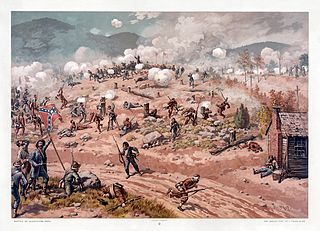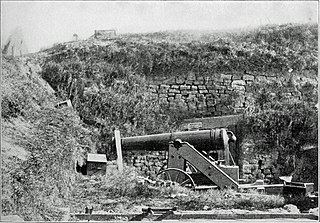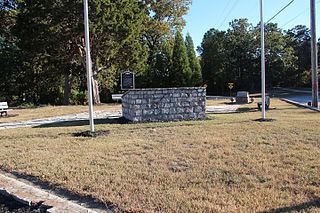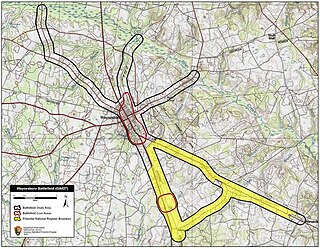 W
WThe Battle of Adairsville also known as the Battle of Cassville, was a battle of the Atlanta Campaign fought during the American Civil War on May 17, 1864, just northeast of Rome, Georgia. The brief engagement was a Confederate delaying action that allowed General Joseph E. Johnston to bait a trap for the Union army at Cassville.
 W
WThe Battle of Allatoona, also known as the Battle of Allatoona Pass, was fought October 5, 1864, in Bartow County, Georgia, and was the first major engagement of the Franklin-Nashville Campaign of the American Civil War. A Confederate division under Maj. Gen. Samuel G. French attacked a Union garrison under Brig. Gen. John M. Corse, but was unable to dislodge it from its fortified position protecting the railroad through Allatoona Pass.
 W
WThe Battle of Altamaha Bridge, also known as the Battle for the Doctortown Railroad Trestle, was an American Civil War engagement fought December 19, 1864, in Wayne County, Georgia, during Sherman's March to the Sea. The Confederate victory prevented Federal forces from destroying a vital railroad bridge during Maj. Gen. William T. Sherman's siege of Savannah, keeping open Confederate supply lines to the city.
 W
WThe Battle of Atlanta was a battle of the Atlanta Campaign fought during the American Civil War on July 22, 1864, just southeast of Atlanta, Georgia. Continuing their summer campaign to seize the important rail and supply hub of Atlanta, Union forces commanded by William Tecumseh Sherman overwhelmed and defeated Confederate forces defending the city under John Bell Hood. Union Maj. Gen. James B. McPherson was killed during the battle. Despite the implication of finality in its name, the battle occurred midway through the campaign, and the city did not fall until September 2, 1864, after a Union siege and various attempts to seize railroads and supply lines leading to Atlanta. After taking the city, Sherman's troops headed south-southeastward toward Milledgeville, the state capital, and on to Savannah with the March to the Sea.
 W
WRuff's Mill and Concord Covered Bridge, in Smyrna, Georgia, was listed on the National Register of Historic Places in 1980.
 W
WThe Battle of Buck Head Creek was the second battle of Sherman's March to the Sea, fought November 28, 1864, during the American Civil War. Union Army cavalry under Brig. Gen. Hugh Judson Kilpatrick repulsed an attack by the small Confederate cavalry corps under Maj. Gen. Joseph Wheeler, but abandoned its attempt to destroy railroads and rescue Union prisoners of war.
 W
WThe Battle of Chickamauga, fought on September 18–20, 1863, between U.S. and Confederate forces in the American Civil War, marked the end of a Union offensive, the Chickamauga Campaign, in southeastern Tennessee and northwestern Georgia. It was the first major battle of the war fought in Georgia, the most significant Union defeat in the Western Theater, and involved the second-highest number of casualties after the Battle of Gettysburg.
 W
WThe Battle of Dallas was an engagement during the Atlanta Campaign in the American Civil War. The Union army of William Tecumseh Sherman and the Confederate army led by Joseph E. Johnston fought a series of battles between May 25 and June 3 along a front stretching northeast from Dallas toward Acworth, Georgia. At Dallas a probe launched by William B. Bate's and William Hicks Jackson's Confederate divisions accidentally turned into a full-scale assault against the defenses of John A. Logan's XV Corps. The attack was driven off with heavy Confederate losses. The previous Union defeats at New Hope Church and the Pickett's Mill are sometimes considered with Dallas as part of one battle.
 W
WThe Battle of Ezra Church, also known as the Battle of Ezra Chapel and the Battle of the Poor House, was fought on July 28, 1864, in Fulton County, Georgia, during the American Civil War. Part of the Atlanta Campaign, the battle featured Maj. Gen. William T. Sherman's Union Army of the Tennessee against the Army of Tennessee, commanded by Lt. Gen. John B. Hood, which was defending the Confederate stronghold of Atlanta, Georgia.
 W
WThe Second Battle of Fort McAllister took place December 13, 1864, during the final stages of Maj. Gen. William T. Sherman's March to the Sea during the American Civil War. Union forces overwhelmed a small Confederate force defending the strategically important Fort McAllister near Savannah, Georgia, a major Federal objective.
 W
WThe Battle of Gilgal Church was an action during the Atlanta Campaign in the American Civil War. The Union army of William Tecumseh Sherman and the Confederate army led by Joseph E. Johnston fought a series of battles between June 10 and 19 along a front stretching northeast from Lost Mountain to Pine Mountain to Brushy Mountain. At Gilgal Church, attacks by the divisions of John W. Geary and Daniel Butterfield of Joseph Hooker's XX Corps were repulsed with nearly one thousand casualties by Confederates from William J. Hardee's corps. That day, in a separate action, troops from Francis Preston Blair Jr.'s XVII Corps overran a Confederate skirmish line, capturing a few hundred Confederates. Gilgal Church was part of a series of minor actions that included the Battle of Latimer's Farm on June 17–18.
 W
WThe Battle of Jonesborough was fought August 31–September 1, 1864, during the Atlanta Campaign in the American Civil War. Two Union armies led by Maj. Gen. William T. Sherman maneuvered to draw the Army of Tennessee away from their defenses at Atlanta, Georgia, so it could be destroyed.
 W
WThe Battle of Kennesaw Mountain was fought on June 27, 1864, during the Atlanta Campaign of the American Civil War. It was the most significant frontal assault launched by Union Maj. Gen. William T. Sherman against the Confederate Army of Tennessee under Gen. Joseph E. Johnston, ending in a tactical defeat for the Union forces. Strategically, however, the battle failed to deliver the result that the Confederacy desperately needed—namely a halt to Sherman's advance on Atlanta.
 W
WThe Battle of Marietta was a series of military operations from June 9 through July 3, 1864, in Cobb County, Georgia, between Union and Confederate forces during the American Civil War. The Union forces, led by Maj. Gen. William Tecumseh Sherman, encountered the Confederate Army of Tennessee, led by Gen. Joseph E. Johnston, entrenched near Marietta, Georgia.
 W
WThe First Battle of Fort McAllister was a series of naval attacks that took place from January 27 to March 3, 1863, in Bryan County, Georgia, during the American Civil War. The commander of the South Atlantic Blockading Squadron Rear Adm. Samuel F. Du Pont decided to test operation of new monitors against Fort McAllister before conducting a major naval operation against Charleston, South Carolina.
 W
WThe Battle of New Hope Church was a clash between the Union Army under Major General William T. Sherman and the Confederate Army of Tennessee led by General Joseph E. Johnston during the Atlanta Campaign of the American Civil War. Earlier in May, Sherman successfully maneuvered Johnston's army into retreating from three positions. However, when Sherman's army crossed the Etowah River and attempted to move around Johnston's left flank, the Confederate general was able to shift troops in time to block the move. At New Hope Church, the Union XX Corps under Joseph Hooker aggressively pressed forward but its attack received a stinging repulse by one division from John Bell Hood's Confederate corps.
 W
WThe Battle of Peachtree Creek was fought in Georgia on July 20, 1864, as part of the Atlanta Campaign in the American Civil War. It was the first major attack by Lt. Gen. John Bell Hood since taking command of the Confederate Army of Tennessee. The attack was against Maj. Gen. William T. Sherman's Union army, which was perched on the doorstep of Atlanta. The main armies in the conflict were the Union Army of the Cumberland, commanded by Maj. Gen. George Henry Thomas and two corps of the Confederate Army of Tennessee.
 W
WThe Battle of Pickett's Mill was fought on May 27, 1864, in Paulding County, Georgia, during the American Civil War between Union and Confederate forces. Union Maj. Gen. William Tecumseh Sherman attempted an attack on the right flank of Confederate Gen. Joseph E. Johnston.
 W
WThe Battle of Resaca was part of the Atlanta Campaign of the American Civil War. The battle was waged in both Gordon and Whitfield counties, Georgia, May 13–15, 1864. It ended inconclusively with the Confederate Army retreating. The engagement was fought between the Military Division of the Mississippi on the side of the Union and the Army of Tennessee for the Confederates.
 W
WThe Battle of Ringgold Gap was fought November 27, 1863, outside the town of Ringgold, Georgia, by the Confederate and Union armies during the American Civil War. Part of the Chattanooga Campaign, it followed a heavy Confederate loss at the Battle of Missionary Ridge from which General Braxton Bragg's artillery and wagon trains were forced to retreat south. The five hour Battle of Ringgold Gap resulted in the Confederate victory of Major General Patrick R. Cleburne and gave the Army of Tennessee safe passage to retreat through the Ringgold Gap mountain pass.
 W
WThe Battle of Rocky Face Ridge was fought May 7–13, 1864, in Whitfield County, Georgia, during the Atlanta Campaign of the American Civil War. The Union army was led by Maj. Gen. William Tecumseh Sherman and the Confederate army by Gen. Joseph E. Johnston. Confederates were forced to evacuate their strong position due to a Union flanking movement.
 W
WThe Battle of Wassaw Sound was an American Civil War naval battle between the Confederate ram CSS Atlanta and the Passaic-class ironclad monitors USS Weehawken and USS Nahant and the gunboat USS Cimmerone, which took place on 17 June 1863 in Wassaw Sound, a bay in the present day state of Georgia. Atlanta ran aground while attempting to break the Union blockade, and after a short battle surrendered to the Union forces. Captain Rodgers became a national hero, and he was promoted to commodore and received the Thanks of Congress as a result of his decisive victory.
 W
WThe Battle of Wauhatchie was fought October 28–29, 1863, in Hamilton and Marion counties, Tennessee, and Dade County, Georgia, in the American Civil War. A Union force had seized Brown's Ferry on the Tennessee River, opening a supply line to the Union army in Chattanooga. Confederate forces attempted to dislodge the Union force defending the ferry and again close this supply line but were defeated. Wauhatchie was one of the few night battles of the Civil War.
 W
WThe Battle of Waynesboro was an American Civil War battle fought on December 4, 1864 in eastern Georgia, towards the end of Sherman's March to the Sea. Union cavalry forces under Brig. Gen. Judson Kilpatrick defeated Confederate cavalry led by Maj. Gen. Joseph Wheeler, opening the way for William T. Sherman's armies to approach their objective, Savannah.